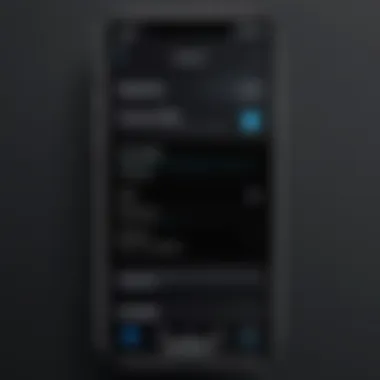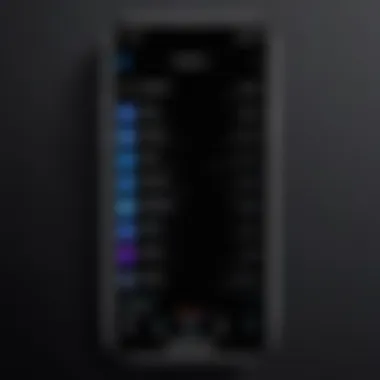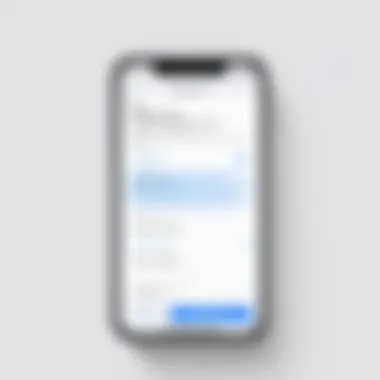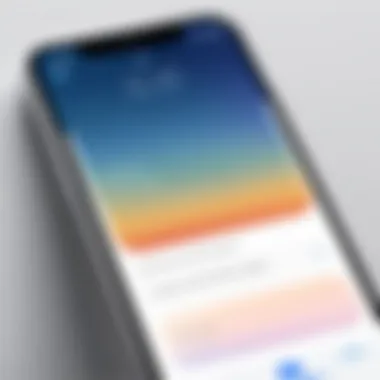How to Block Your Number on iPhone: A Complete Guide


Intro
In a world where privacy is increasingly important, knowing how to manage your phone number visibility can offer significant peace of mind. Many users wish to take control over who sees their phone numbers and for various reasons. Whether you prefer to guard your number during a business call, or keep it hidden for personal matters, blocking your number on an iPhone can be an effective solution. This article offers a step-by-step guide to blocking your number on iPhone, covering both temporary and permanent options, alongside relevant privacy considerations.
Product Overview
The iPhone, a leading product in the smartphone market, offers smart functionalities that enhance user experience, particularly in managing privacy settings.
Key Features
- Built-in Privacy Settings: The iPhone enables users to customize their privacy preferences seamlessly.
- Temporary and Permanent Blocking Options: Users can choose between blocking their number on a per-call basis or setting a permanent block.
- User-Friendly Interface: Even non-tech-savvy individuals can navigate the settings easily.
- Compatibility: Works across various networks and is suitable for both US and international users.
Specifications
The ability to block your number does not require any specific hardware specifications but is contingent on your device running a compatible version of iOS.
- Supported iOS Versions: iOS 10 and onwards support number blocking.
- Carrier Compatibility: Most carriers support number blocking, ensuring broad accessibility.
Performance Analysis
Exploring performance factors associated with number blocking features can enhance your understanding.
Speed and Efficiency
Blocking numbers is quick and does not strain the iPhone’s processing capability. With just a few taps, you can establish whether you wish to temporarily block your number for one call or implement a more permanent solution.
Battery Life
Engaging privacy settings, including number blocking, do not significantly impact battery life. Regular use of these features remains efficient compared to heavy data usage applications.
"Effective privacy management can boost both personal comfort and security in today's digital landscape."
Ending
Understanding how to block your number on an iPhone empowers users to maintain more control over their communications. As the demand for privacy continues to grow, utilizing the phone's built-in tools enhances your ability to navigate social and professional interactions securely.
Prolusion
In today's digital age, the need to protect one’s privacy has become increasingly important. Blocking your number on iPhone is one effective strategy to maintain your anonymity when making calls. This feature is relevant not just for personal safety but also for avoiding unwanted calls or maintaining a level of professional discretion.
Understanding how to block your number is essential for several reasons. Firstly, it empowers you to control who can see your contact information. This is particularly relevant in a world where unsolicited calls and spam messages have risen sharply. By using this feature, users can reclaim a degree of privacy that often feels lost in a hyper-connected environment.
Moreover, blocking your number can be useful in preserving relationships. For instance, if you are in a situation requiring sensitivity—such as a workplace scenario or a potential romantic interest—you may not want every caller to know your number. This practical knowledge equips individuals with the necessary tools to navigate their communications with confidence and assurance.
Additionally, different methods exist to block your number on the iPhone. Familiarity with these options can enhance a user’s experience. Users can choose between wiping their information for specific calls or initiating a more permanent solution. This article will explore both temporary and permanent methods to block your number, allowing you to select what best suits your needs. By understanding these processes, you can better manage your privacy, making informed decisions regarding your call history and digital presence.
Understanding Caller Blocking
Caller ID blocking serves as a pivotal feature in mobile communication, offering users greater control over their privacy. When you block your number, your identity is obscured, preventing recipients from seeing your caller information. This section delves deeper into the dimensions and significance of this technology, illustrating the benefits and considerations linked to it.
What is Caller Blocking?
Caller ID blocking is a method that allows individuals to hide their phone number from the recipient when making a call. This feature can be activated through various means, such as using specific codes before dialing or adjusting settings on your mobile device. When engaged, it transmits a signal to the recipient's network that indicates the call is anonymous or masked.
This practice is not merely a function of convenience; it plays a crucial role in safeguarding personal information. Users may choose to block their numbers for a variety of reasons, including privacy concerns or to avoid harassment. In a world where phone numbers can be easily associated with personal or sensitive information, understanding how to effectively manage Caller ID is increasingly important.


Why Block Your Number?
Blocking your number can be advantageous for several reasons. Firstly, it enhances privacy during interactions. When communicating with unfamiliar contacts, such as in business negotiations or when dealing with customer service, concealing your number prevents unwanted follow-up calls. Secondly, number blocking can act as a deterrent against spam calls. Individuals troubled by persistent telemarketing can introduce a layer of protection between them and unsolicited callers.
There are also scenarios where one might need to protect their identity for safety reasons. This could apply to individuals in sensitive situations, such as victims of stalking or harassment. By blocking the number, they minimize the risk of unwanted contact or repercussions.
Furthermore, in today's digital age, maintaining privacy online is essential. Users often seek ways to detach their caller identity from their personal information. Adjusting Caller ID settings can be a strategic move to achieve this.
"Understanding how Caller ID blocking works is an essential part of managing one’s privacy in a tech-driven world."
In summary, the decision to block your number is influenced by various factors: privacy, control over personal information, and protection from unwanted solicitation. As we explore further, it is vital to grasp the practical methods available for blocking your number, ensuring you have the tools needed to manage your privacy effectively.
Temporary Number Blocking Methods
Temporary number blocking methods are crucial for maintaining privacy in specific situations. Unlike permanent options, these methods allow for flexibility. You might need to keep your number private when calling a specific individual or when contacting a business. Thus, the ability to temporarily block your number adds an important layer of control over your personal information.
By implementing these methods, the benefits include protecting your identity and reducing unwanted callbacks. It also helps in scenarios where you want to assess a service without revealing your contact details. Ultimately, temporary blocking is an excellent solution for maintaining privacy, particularly in negotiations, sales calls, or when responding to advertisements.
Using Prefix Codes
Using prefix codes is one of the simplest ways to block your number temporarily on an iPhone. Before dialing, you insert a specific code, usually *67 in the United States. This code signals the network to hide your caller ID for that specific call. To use it effectively, dial *67 followed by the number you wish to call.
For example:
*Dial: 67 123-456-7890
This technique ensures that your number is obscured without altering any settings on your device. It is important to note that not all calls will be blocked. Some services or numbers might still identify you, especially emergency services or toll-free numbers.
iPhone Settings for Temporary Block
Another method for temporary blocking involves utilizing your iPhone settings. Although you cannot block your number for every outgoing call through settings, there are options to control specific functionalities that can aid in privacy. For instance, you can use the "Hide My Caller ID" feature by following these steps:
- Open the Settings app on your iPhone.
- Scroll down and tap on Phone.
- Select Show My Caller ID.
- Switch the toggle to off.
This action will prevent your number from being displayed for calls made from your device. Remember to toggle this back on once you are done making the necessary calls. Generally, this method offers a quick way to manage your privacy.
Important Note: Blocking your number may not always guarantee complete anonymity. Some services may still trace your number through advanced technology.
Permanent Number Blocking Methods
In the context of privacy management, understanding Permanent Number Blocking Methods is pivotal for iPhone users. This section delves into methodologies that allow individuals to consistently refrain from revealing their phone number during outbound calls. Notably, this approach not only caters to personal privacy but also reduces the risk of unwanted communications such as spam or harassing calls. Users seeking a reliable method to control their visibility will find these options indispensable.
Adjusting iPhone Settings
To adjust your iPhone settings for permanent number blocking, follow these steps carefully:
- Open the Settings app on your iPhone.
- Scroll down and tap on Phone.
- Locate the option labeled Show My Caller ID.
- Toggle the switch to Off.
Once this is completed, your number will be hidden when you make calls. This method is straightforward and provides a level of anonymity in your communications. However, be aware that some recipients may not accept calls from unknown numbers. Thus, consider the context in which you are calling.
Carrier-Specific Options
Different mobile carriers offer unique solutions for blocking your number. This can be advantageous for users who wish to maintain privacy without altering their phone settings each time.
- AT&T: To block your number, dial *67 before the number you are calling. For permanent blocking, contact customer service for options in your plan.
- Verizon: Similar to AT&T, Verizon allows you to use *67 for temporary blocking. For permanent solutions, check the My Verizon app or website for instructions tailored to your account.
- T-Mobile: Similar approaches apply. Use *67 for one-off calls, while discussing permanent options directly with T-Mobile’s support.
- Sprint: Provides options through their My Sprint app that may include blocking features tailored to user preferences.
Adapting these carrier-specific options can complement adjustments made in your phone settings. Given that each carrier may implement varied procedures and services, it is recommended to consult the official website or customer support for the most accurate guidance.


Remember: Not all services align perfectly. If one option does not operate as desired, ensure to explore another, as user experiences often differ based on specific account settings or geographic factors.
Using Do Not Disturb for Privacy
The Do Not Disturb feature on iPhone is not only a tool for silencing notifications but also serves as a powerful privacy measure. In an era where personal information is highly valued, using Do Not Disturb allows you to control who can contact you and when, thereby asserting more privacy over your communications. This is especially relevant for those who may have concerns about unsolicited calls or messages.
With Do Not Disturb, you can effectively filter calls, ensuring that your phone only rings for important contacts or during specific hours. It offers a layer of security by minimizing interruptions from unknown or unsolicited callers. This can be particularly beneficial when needing focus time or when you simply do not wish to engage with everyone. Furthermore, it allows better management of social interactions, making it a vital component in the privacy toolkit for iPhone users.
Configuring Do Not Disturb
To enable Do Not Disturb, begin by navigating to the Settings app. Scroll down to locate and select "Do Not Disturb." Here you can toggle the feature on and define your preferences. You can allow calls from everyone, no one, or just contacts or favorites.
Additionally, you can schedule Do Not Disturb for specific hours. For instance, if you wish to avoid disturbances during your nighttime rest or during meetings, setting a schedule eliminates the need to manually turn it on or off. This is particularly useful for ensuring you have uninterrupted periods when focus is required.
This is a step-by-step way to configure it:
- Open the Settings app.
- Tap on Do Not Disturb.
- Toggle Manual to turn it on.
- Set a Scheduled Time if needed.
- Choose Allow Calls From to set preferences.
Managing Allowed Contacts
To maximize the effectiveness of Do Not Disturb, it is crucial to fine-tune the "Allowed Contacts". This feature allows you to maintain connection with important people. While in the Do Not Disturb settings, select Allow Calls From. Here, you can choose to allow calls from:
- Everyone
- No One
- Favorites
- Groups of contacts (if applicable)
Choosing "Favorites" ensures only those marked as important in your contacts can reach you while the rest are silenced. This maintains your privacy without completely isolating you.
Remember that this setting does not affect messages or notifications from apps unless you configure them separately.
Managing allowed contacts is particularly valuable for professionals who need to balance privacy with accessibility. It's essential for maintaining a good blend of personal space and availability. Without a doubt, utilizing Do Not Disturb in this way enhances your overall privacy experience while using your iPhone.
Effects of Blocking Your Number
Blocking your number can have several important effects that users should understand. It alters the way others perceive calls and messages, while also enhancing privacy. Knowing these effects can better inform your decision on when and how often to employ this feature on your iPhone.
When you block your number, the recipient cannot see your phone number on their caller ID. This can create a layer of anonymity which is beneficial for both personal and professional scenarios. For instance, if you need to make a business call but do not wish to share your personal number, blocking it allows you to communicate without revealing your identity.
Another key consideration is the impact on trust. Some callers may be suspicious of calls from a blocked number. They may hesitate to answer, thinking it is spam or a telemarketer. This can lead to missed opportunities for important calls. In contexts involving sensitive or confidential matters, this can be a double-edged sword. It’s thus vital to assess the situation before deciding to block your number.
What Callers See
When you call from a blocked number, the recipient sees "Unknown" or "Private Number" on their phone screen. This lack of identification can lead to confusion. In the case of personal calls, the lack of transparency might prompt a recipient to ignore a call altogether.
Moreover, this result not only prevents identification but also affects how calls are prioritized by the recipient. Many individuals have become accustomed to screening their calls. If a call comes from an unidentified number, they might assume it’s unwanted and decide not to pick up.
This dynamic can lead to potential communication breakdowns, particularly in urgent or important matters. It is important for users to consider that blocking their number could lead to unintended consequences in their communication.
Impact on Messaging and Apps
While blocking your number mainly impacts voice calls, it also influences your use of messaging services and apps. For instance, when you send an SMS or use apps like WhatsApp, your name or number may not appear if you are using a blocked number. This could complicate discussions with contacts who expect to see your name or number attached to messages.
In terms of third-party applications, privacy settings often utilize your phone number as an identifier. If your number is hidden, this could affect both user experience and functionality, such as account recoveries or verification codes that depend on an identifiable number.
As a tech-savvy user, it is essential to be aware of how number blocking can ripple across various messaging platforms. Careful consideration is necessary to fully understand how to maintain your privacy without hindering effective communication across your devices.
Advanced Privacy Features on iPhone


Privacy has become a paramount concern in today's digital landscape. The iPhone offers various advanced privacy features that allow users to manage their personal information more effectively. These features not only enhance user security but also provide control over how and when information is shared. Understanding these privacy settings is crucial for anyone who values their personal data.
Hide My Number Feature
The Hide My Number feature on the iPhone is designed for users who wish to maintain anonymity when making calls. This option enables users to block their caller ID, ensuring that recipients do not see the caller's number. Activating this feature is quite straightforward. Users can go to the Phone settings, find the option for Caller ID, and choose to conceal their number.
Benefits of this feature include:
- Enhanced privacy: Users can communicate without revealing their personal number.
- Increased security: It reduces the chances of unwanted callbacks or harassment.
- Toggle availability: Users can easily switch this feature on or off based on their needs, providing flexibility in privacy management.
To enable this feature, navigate to Settings > Phone and look for Show My Caller ID. Toggle it off to hide your number during calls. Remember that while this feature provides a layer of anonymity, it may not work for all recipients. Some carrier restrictions may apply.
FaceTime and Number Privacy
FaceTime has integrated privacy features as well. Users often overlook privacy options related to FaceTime calls, but these settings are essential for safeguarding communication. Users can choose to share their phone number or Apple ID for FaceTime calls, which means they can control who can contact them.
Considerations for FaceTime privacy include:
- Selective sharing: Users can decide whether to receive calls from specific contacts or not.
- No Caller ID: Similar to regular calls, FaceTime can also be used without sharing a number, enhancing anonymity.
- Security features: FaceTime uses end-to-end encryption, making calls secure and harder for hackers to intercept.
To manage FaceTime privacy settings, go to Settings > FaceTime. Here, you can choose how to be contacted and can enable or disable features as needed.
It is essential to regularly review your privacy settings on the iPhone to ensure that they align with evolving needs and potential security threats.
Troubleshooting Common Issues
In the quest to ensure privacy through number blocking on iPhone, users may encounter several frustrating hurdles. Being aware of these common issues is paramount. This understanding not only saves time and effort but also enhances user confidence in navigating their privacy settings.
Technical glitches or misconfigurations can render the blocking methods ineffective. Therefore, knowing how to troubleshoot these issues is beneficial. It helps clarify misconceptions, ensuring users know what to expect. Also, some problems can stem from the carrier configurations or specific iPhone settings. Recognizing the source of an issue can lead to quicker resolutions, allowing users to regain control of their privacy.
Not Working as Expected
When users find that blocking their number is not functioning as intended, it can be perplexing. Here are a few common reasons why this may happen:
- Settings Misconfiguration: Sometimes, a simple oversight in the settings can lead to the blocking feature not working. Ensure that the "Show My Caller ID" option is toggled off in the phone settings.
- Network Issues: Poor connectivity can sometimes affect settings changes. A simple restart of the device or checking the network can help identify if this is the issue.
- Usage of Specific Apps: Some messaging or calling apps may not recognize the default blocking settings. Users should look into the privacy settings within those specific apps.
To tackle these issues, users should first double-check their settings. If everything seems correct, restarting the phone usually provides a refresh that resolves minor glitches. If the problem persists, reaching out to Apple support or visiting relevant online forums could shed light on more complex issues.
Carrier-Related Problems
Carrier interference can also pose challenges when attempting to block your number. Various factors can contribute to these kinds of issues, including:
- Carrier Restrictions: Some carriers may have policies that impact number blocking features. It might be worth checking with the carrier about specific capabilities or limitations.
- Account Type: The type of phone plan can affect blocking capabilities. Prepaid plans may have restrictions compared to postpaid ones.
- Software Compatibility: Older versions of iOS could create compatibility issues with blocking settings. Updating the device regularly is important for optimal performance.
For those experiencing these problems, it is advisable to contact their carrier's customer service. They can provide precise information regarding whether number blocking is available on their service plan. Alternatively, checking community discussions on platforms like Reddit can offer insights from other users facing similar difficulties. This can be particularly helpful as it often leads to solutions shared by experienced users.
"Understanding your carrier's policies can significantly enhance your experience when managing your privacy on your iPhone."
By addressing the common challenges associated with number blocking, users can focus more on enjoying their privacy while communicating. Identifying and resolving these troubleshooting issues ensures a more efficient use of iPhone's privacy settings.
Epilogue
Blocking your number on an iPhone is more than just a convenience; it’s a critical aspect of personal privacy in today’s digital world. As communication becomes increasingly intertwined with our private lives, understanding the mechanics behind number blocking offers significant benefits.
Firstly, it empowers users to control their interactions, allowing them to choose when and how their number is presented to others. This can be invaluable in professional situations, where maintaining boundaries is essential. It also adds a layer of protection against unwanted attention or harassment, enhancing users' overall safety.
Furthermore, the methods of blocking your number can vary depending on the situation. Readers should recognize that understanding both temporary and permanent options can serve distinct needs. For instance, using prefix codes for one-off calls might be sufficient for some, while others may prefer to adjust settings for ongoing privacy.
The advanced features available on the iPhone, such as the Hide My Number function, illustrate the strides made in personal privacy technologies. These options demonstrate the importance of being tech-savvy, ensuring users are aware of the tools at their disposal to manage privacy effectively.
"In an era where privacy is constantly at risk, knowing how to safeguard one’s digital footprint becomes imperative."
As this article highlights various blocking techniques, readers should take these insights to heart. Whether for personal, professional, or general safety, learning about caller ID blocking is a step towards harnessing control over one’s communication. It’s not merely about blocking a number; it’s about asserting independence and protecting oneself in a connected world. Understanding and employing these methods can provide significant peace of mind, demonstrating the practical value of knowing how to manage one's privacy settings on an iPhone.



